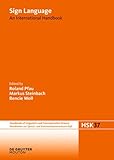Sign Language : An International Handbook / ed. by Roland Pfau, Markus Steinbach, Bencie Woll.
Material type: TextSeries: Handbücher zur Sprach- und Kommunikationswissenschaft / Handbooks of Linguistics and Communication Science [HSK] ; 37Publisher: Berlin ; Boston : De Gruyter Mouton, [2012]Copyright date: ©2012Description: 1 online resource (1126 p.)Content type:
TextSeries: Handbücher zur Sprach- und Kommunikationswissenschaft / Handbooks of Linguistics and Communication Science [HSK] ; 37Publisher: Berlin ; Boston : De Gruyter Mouton, [2012]Copyright date: ©2012Description: 1 online resource (1126 p.)Content type: - 9783110204216
- 9783110261325
- online - DeGruyter
- Issued also in print.
| Item type | Current library | Call number | URL | Status | Notes | Barcode | |
|---|---|---|---|---|---|---|---|
 eBook
eBook
|
Biblioteca "Angelicum" Pont. Univ. S.Tommaso d'Aquino Nuvola online | online - DeGruyter (Browse shelf(Opens below)) | Online access | Not for loan (Accesso limitato) | Accesso per gli utenti autorizzati / Access for authorized users | (dgr)9783110261325 |
Frontmatter -- Preface -- Contents -- Notational conventions -- Sign language acronyms -- 1. Introduction -- I. Phonetics, phonology, and prosody -- 2. Phonetics -- 3. Phonology -- 4. Visual prosody -- II. Morphology -- 5. Word classes and word formation -- 6. Plurality -- 7. Verb agreement -- 8. Classifiers -- 9. Tense, aspect, and modality -- 10. Agreement auxiliaries -- 11. Pronouns -- III. Syntax -- 12. Word order -- 13. The noun phrase -- 14. Sentence types -- 15. Negation -- 16. Coordination and subordination -- 17. Utterance reports and constructed action -- IV. Semantics and pragmatics -- 18. Iconicity and metaphor -- 19. Use of sign space -- 20. Lexical semantics: Semantic fields and lexical aspect -- 21. Information structure -- 22. Communicative interaction -- V. Communication in the visual modality -- 23. Manual communication systems: evolution and variation -- 24. Shared sign languages -- 25. Language and modality -- 26. Homesign: gesture to language -- 27. Gesture -- VI. Psycholinguistics and neurolinguistics -- 28. Acquisition -- 29. Processing -- 30. Production -- 31. Neurolinguistics -- 32. Atypical signing -- VII. Variation and change -- 33. Sociolinguistic aspects of variation and change -- 34. Lexicalization and grammaticalization -- 35. Language contact and borrowing -- 36. Language emergence and creolisation -- 37. Language planning -- VIII. Applied issues -- 38. History of sign languages and sign language linguistics -- 39. Deaf education and bilingualism -- 40. Interpreting -- 41. Poetry -- IX. Handling sign language data -- 42. Data collection -- 43. Transcription -- 44. Computer modelling -- Indexes -- Index of subjects -- Index of sign languages -- Index of spoken languages
restricted access online access with authorization star
http://purl.org/coar/access_right/c_16ec
Sign language linguists show here that all questions relevant to the linguistic investigation of spoken languages can be asked about sign languages. Conversely, questions that sign language linguists consider - even if spoken language researchers have not asked them yet - should also be asked of spoken languages. The HSK handbook Sign Language aims to provide a concise and comprehensive overview of the state of the art in sign language linguistics. It includes 44 chapters, written by leading researchers in the field, that address issues in language typology, sign language grammar, psycholinguistics, neurolinguistics, sociolinguistics, and language documentation and transcription. Crucially, all topics are presented in a way that makes them accessible to linguists who are not familiar with sign language linguistics.
Issued also in print.
Mode of access: Internet via World Wide Web.
In English.
Description based on online resource; title from PDF title page (publisher's Web site, viewed 28. Feb 2023)


